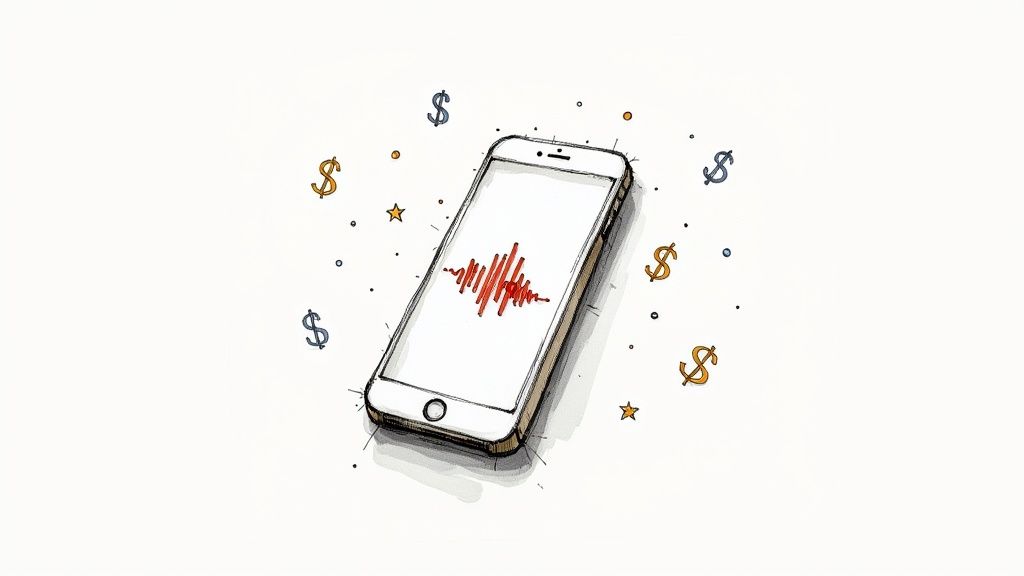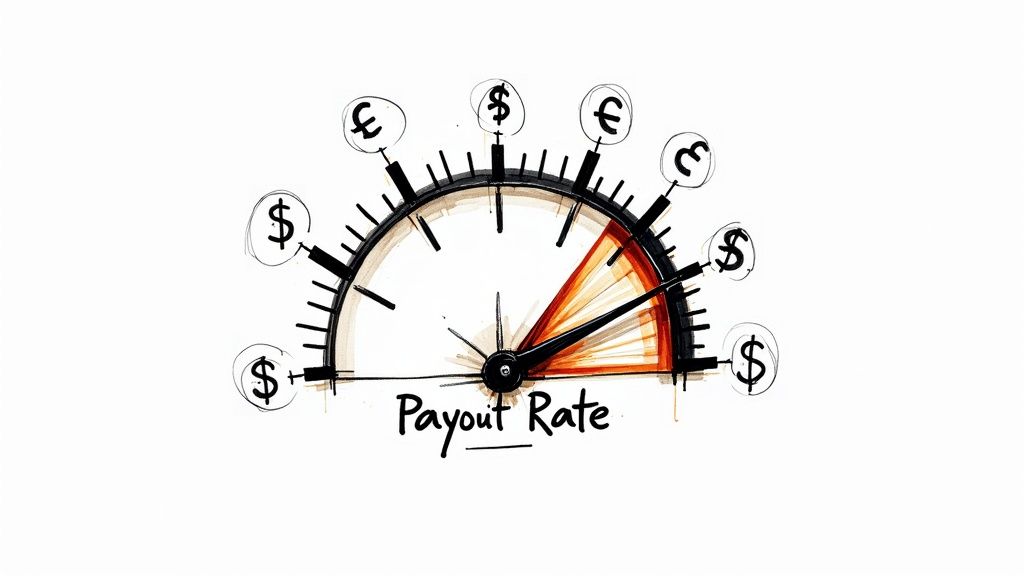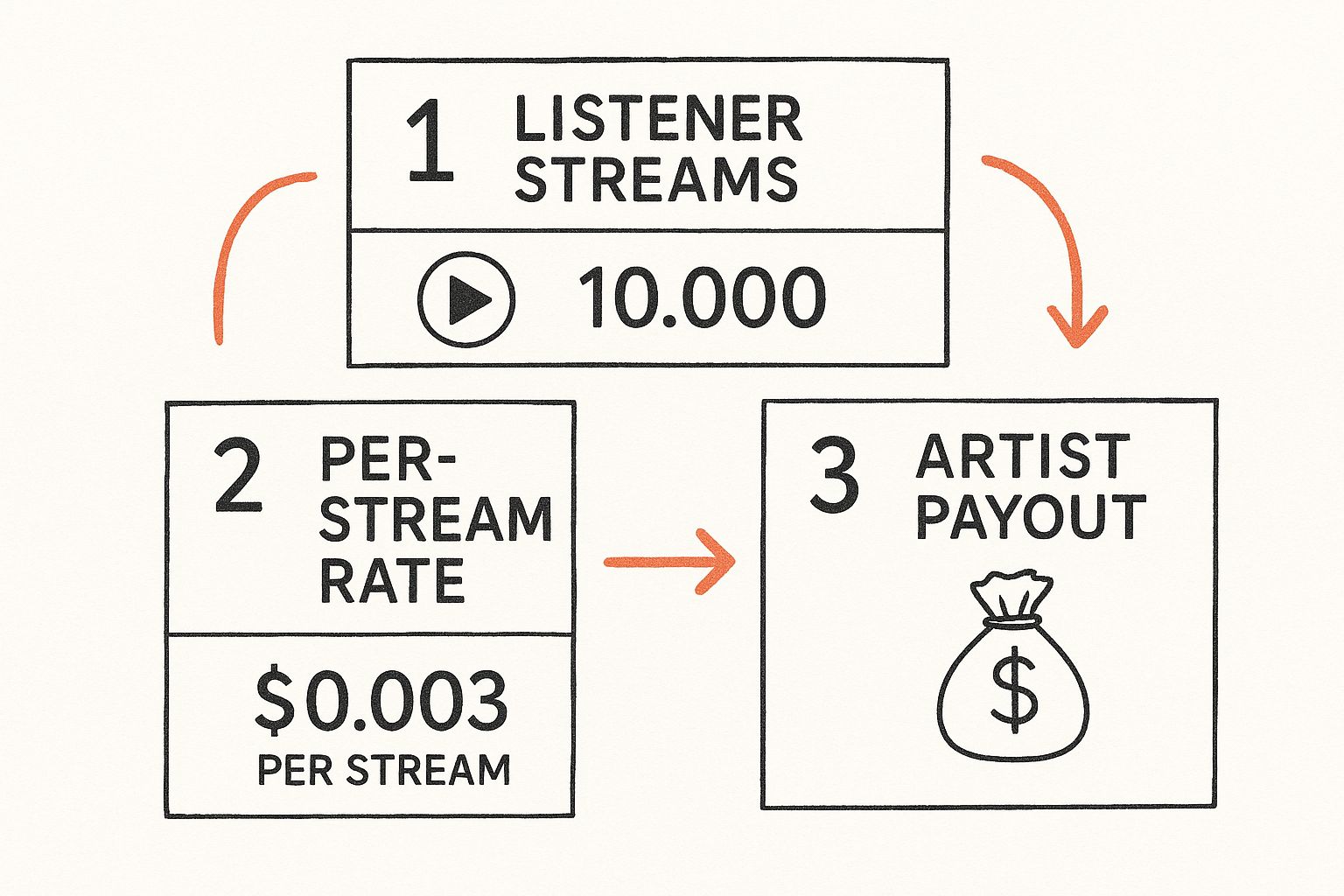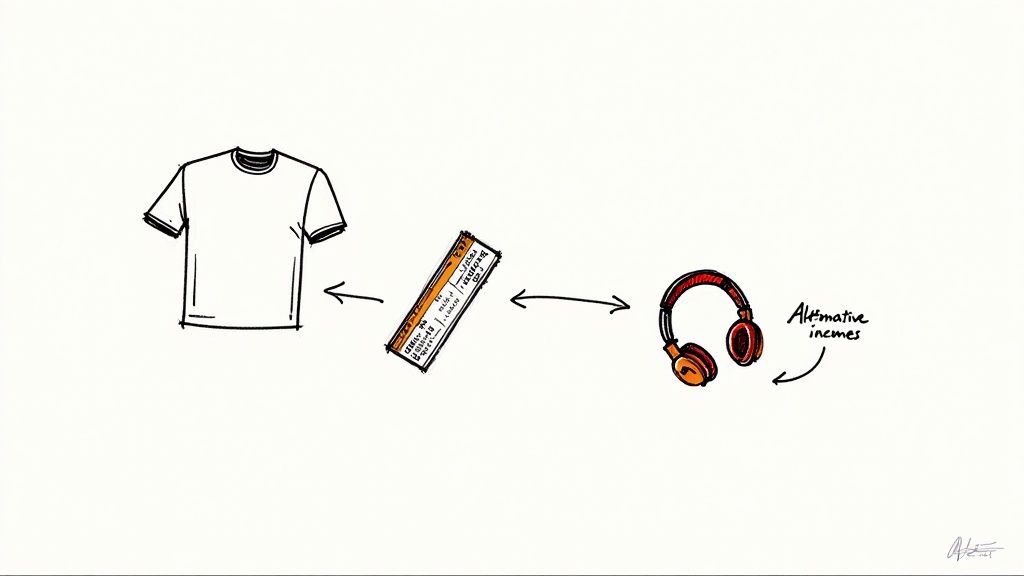How Do Artist Earn Money on Spotify in 2024? Proven Strategies
- midbrook.contact
- Aug 11
- 14 min read
So, you want to make a living from your music on Spotify? The first thing to get your head around is how the money actually flows. It’s not as simple as getting a fixed penny-per-play. Instead, it’s all about royalties, and the system can feel a bit murky at first.
Let's pull back the curtain.
Decoding How Spotify Royalties Actually Work

Forget everything you've heard about a fixed "per-stream rate." It doesn't exist. Spotify works on what's called a pro-rata model. Think of it like a giant pot of money collected every month from all the Premium subscriptions and ad revenue.
Spotify takes its share off the top (roughly 30%), and the remaining 70% becomes the royalty pool. This is the money that gets paid out to rights holders—the artists, labels, and publishers.
Your slice of that pie is determined by your "streamshare." If your songs racked up 1% of all the total streams on the platform that month, you (and your team) get 1% of that royalty pool. It’s a simple concept, but it has huge implications for your earnings.
Why Your Per-Stream Payout is Always Changing
This pro-rata system is precisely why your earnings can feel so unpredictable. The value of a single stream isn't static; it swings based on who is listening and where they are.
Premium vs. Free Listeners: A stream from a paid Premium subscriber is worth a whole lot more than one from someone on the free, ad-supported plan. The Premium revenue pool is much richer.
Listener Location: Geography plays a massive role. A stream from the U.S. or a Scandinavian country, where subscription prices are higher, will net you more than a stream from a region with lower subscription costs.
Because of these variables, your earnings can go up or down even if your stream count stays exactly the same. It's all about the quality of your streams, not just the quantity.
For a more detailed breakdown of the different types of royalties, our guide on what is a royalty in music explained is a great resource.
The table below breaks down the main factors that directly influence your per-stream earnings.
Spotify Payout Factor Breakdown
Influencing Factor | Impact on Earnings | Example |
|---|---|---|
Listener Subscription Tier | High | A stream from a $10.99/mo Premium user pays significantly more than a stream from an ad-supported free user. |
Listener's Country | High | A play from a listener in Switzerland (high subscription cost) earns more than a play from a country with a lower-priced plan. |
Your Distribution Agreement | Medium | The percentage your distributor or label takes directly affects your final payout. A 15% distribution fee leaves you with 85% of earnings. |
Total Monthly Streams | Medium | The more total streams on Spotify in a month, the smaller each individual artist's "streamshare" becomes, slightly diluting the per-stream value. |
Ultimately, your focus should be on building a dedicated audience in high-value markets.
The Big Takeaway: Stop obsessing over the "dollars per stream" metric. Your real goal is to increase your streamshare. You want a bigger piece of the overall listening pie, and the best way to do that is by attracting high-value listeners who will play your music again and again.
The New Gatekeeper: The 1,000-Stream Annual Threshold
Spotify recently threw a new wrench in the works. As of early 2024, a track now needs to hit at least 1,000 streams within the last 12 months to even qualify for royalties.
This change was put in place to fight the flood of bot-driven artificial streams and make sure money is going to active, legitimate artists. For a brand new artist, 1,000 streams can feel like a mountain to climb, but it’s a clear signal from Spotify: they want you to focus on building a real, engaged fanbase.
This rule shifts the game from chasing tiny fractions of a cent to building a sustainable career. While those per-stream payouts often land somewhere between $0.003 and $0.005, you won't see a dime until you cross that 1,000-stream threshold. It's the first real milestone on your path to earning.
Setting Up Your Music for Success
Before you can earn a single cent, your music has to actually be on Spotify. And here's the first thing every new artist needs to know: you can't just upload it yourself. You need to go through a music distributor. Think of them as the digital gatekeepers who get your tracks onto all the major streaming platforms, not just Spotify. Choosing the right one is your first major business decision as an artist.
Some of the biggest names you'll hear are DistroKid, TuneCore, and CD Baby. They all do the same core job, but how they charge you is completely different. DistroKid is known for its annual flat-fee model for unlimited uploads, which is a dream for artists who are constantly creating. TuneCore, on the other hand, tends to charge you per release each year, while CD Baby leans toward a one-time setup fee per release with no recurring costs. The best choice really comes down to your release strategy—are you dropping singles every month or a full album every two years?
Getting Your Release Ready for the World
Once you've picked a distribution partner, it's time to get your assets in order. This is about more than just having a finished song. You're creating a professional package that meets Spotify's technical requirements and, more importantly, catches the eye of potential listeners.
Here’s a no-nonsense checklist of what you'll absolutely need:
High-Quality Audio: Don't cut corners here. Your master file should be a WAV (16-bit, 44.1 kHz). If you upload an MP3, it’s already compressed, and Spotify will compress it again, which can seriously degrade your sound quality.
Killer Artwork: Your cover art is your visual handshake. It needs to be a crisp, high-resolution square image, at least 3000x3000 pixels. It's what people see before they ever hear a note. Make it count.
Spot-On Metadata: This is the boring but critical part. Your artist name, song title, featured artists, and songwriter credits must be perfect. Any mistake here can mean lost royalties or your music getting lost in the digital void.
Nailing these details upfront saves you from a world of technical headaches and ensures you look like a pro from day one.
Claim Your Spotify for Artists Profile—Do It Yesterday
The second your distributor confirms your music has been submitted to Spotify, drop everything and claim your Spotify for Artists profile. This is your mission control, and getting access before your music goes live is one of the most powerful moves you can make.
Don't wait. Claiming your profile early unlocks the single most important promotional tool you have: the ability to pitch your unreleased music directly to Spotify's editorial team for a shot at a major playlist.
This is what your home base will look like inside the Spotify for Artists dashboard.

From here, you can track your stats, pitch new songs, and customize your public-facing profile. A complete profile—with a great bio, professional photos, and links to your socials—does more than just tell your story. It signals to both Spotify and its listeners that you’re a serious artist worth paying attention to. It’s often the first deep dive a new fan takes, so give them something to connect with.
The Art of Getting on Powerful Playlists
Let's be real: playlists are the lifeblood of Spotify. They're what separates a track that gets a handful of plays from one that reaches tens of thousands, and that directly translates into what you earn. But you can't just treat all playlists the same. Your strategy has to be smart.
You’re mainly dealing with two kinds of playlists: editorial and algorithmic. Editorial lists, like the legendary RapCaviar or the indie-focused Lorem, are put together by actual people on Spotify's team. On the other hand, algorithmic lists like Discover Weekly and Release Radar are custom-built for each listener by Spotify's AI based on what they've been playing. You can't directly pitch to an algorithm, but the right moves can definitely get its attention.
Pitching to Spotify's Editorial Team
If you want a shot at an official Spotify editorial playlist, there's only one way in: pitching an unreleased song through your Spotify for Artists dashboard. This is absolutely non-negotiable for any serious release.
You need to submit your track at least seven days before it goes live, but I always tell artists to aim for 2-4 weeks in advance. That gives the editors time to actually listen and consider where it might fit. Don't leave it to the last minute.
Your pitch is your elevator pitch, your one chance to grab an editor's attention. Make it count.
Nail the Vibe: Be super specific with your tags. Don't just say "Pop." Is it a "chill, acoustic, morning" track? Or maybe an "energetic, synth-driven, workout" anthem? The more accurate you are, the easier you make it for an editor to find the perfect home for your song.
Tell a Story: The description box is where you connect. Forget "this is my new single." What’s the story behind the lyrics? What was the creative breakthrough in the studio? Did you collaborate with someone interesting? This is the human element that makes a track memorable among thousands of submissions.
Show Your Work: Briefly mention what you’re doing to promote the song. Are you running social media ads? Premiering a music video? Playing shows? This proves to the editors that you're hustling and that their playlist placement will be part of a bigger push.
My Take: Editors are looking for songs that have a story and momentum. Your pitch needs to convince them that by adding your track, they're not just filling a slot—they're backing an artist who is actively building something real.
This whole process is about turning streams into revenue. This chart gives you a simplified look at how the money flows from a listener's play to your pocket.

As you can see, every single stream matters. And more often than not, those initial streams come from a listener discovering you on a playlist.
Getting on User-Curated Playlists
Beyond the official Spotify fortress, there's a huge ecosystem of playlists run by independent curators. These are your music bloggers, influencers, and die-hard fans who have built their own followings. A spot on one of their lists can be just as game-changing.
The approach here is all about good research and genuine outreach—not spamming.
First, you have to do some digging. Search Spotify for artists who sound like you and check out the user-created playlists they're on. When you find a list that feels right, the hunt for the curator begins. Look for a social media handle, an email, or a website in the playlist's description. It’s often a bit of detective work.
When you do reach out, make it personal. Name the playlist, explain why your specific song is a great fit (and be honest about it), and keep your message short and to the point. Trust me, building a real relationship with a curator who loves your genre is infinitely more valuable than a single, random placement.
Using Spotify for Artists to Actually Grow Your Audience

Your Spotify for Artists dashboard is so much more than a place to watch your stream count. I think of it as my command center, the place where all the raw data lives. This is where you stop guessing and start building a real strategy to earn more from your music on Spotify.
The platform gives you a clear window into who’s listening, where they are, and how they found you. Honestly, digging into these analytics is the first real step toward building an engaged audience that racks up those streams for you.
Turn Audience Data Into Smarter Moves
Your "Audience" tab? It's a goldmine. Seriously. It tells you your listeners' age, gender, and their top cities and countries. This isn't just a list of stats to feel good about; it's a practical roadmap for your marketing.
Imagine you're a folk artist out of Austin, Texas, but your data shows a surprising number of listeners in Stockholm, Sweden. That’s a huge clue. It tells you there's a pocket of potential fans overseas just waiting to hear more from you.
So, what do you do with that information?
Run Targeted Ads: Set up a small, focused ad campaign on Instagram or Facebook. You can target it directly to users in Stockholm who already listen to artists similar to you.
Plan Your Next Tour: Okay, you probably won't book a flight to Sweden tomorrow. But if that listener base keeps growing, it should absolutely influence where you plan your next tour.
Personalize Your Content: Give your Swedish fans a shout-out on social media. It’s a small thing, but it makes them feel seen and helps build a much stronger connection, which encourages them to keep listening.
Getting a handle on this data is the foundation of real growth. For more hands-on strategies, take a look at our guide on how to get more Spotify followers with proven tips to boost your audience.
Put Spotify’s Own Promotional Tools to Work
Beyond just the numbers, Spotify for Artists gives you some powerful tools to pull fans in deeper. These features are designed to make your profile stand out and keep people coming back—which is exactly what you need to boost your streams and your income.
Canvas is one of my favorites. It lets you add a short, looping video to each track. It’s a simple way to turn a static listening experience into something more visually interesting. A track with a cool Canvas is way more likely to get shared on Instagram Stories, which is basically free marketing.
Marquee is another one to know. It’s a paid tool, but it's effective. It creates a full-screen, sponsored pop-up of your new release for listeners who already follow you or have shown interest in your music. It's a direct line to your biggest fans, making sure they don’t miss your new song and helping drive a big spike in streams right out of the gate.
The sheer scale of Spotify is what makes all of this work. A bigger, more engaged audience means you get a bigger slice of the royalty pie. Every one of these features matters because they directly connect audience growth to your income.
Think about the numbers for a second. As of the second quarter of 2025, Spotify reported a staggering 696 million monthly active users and 276 million subscribers, with total revenue climbing to €4.2 billion. With a platform that massive, even capturing a tiny fraction of that audience can mean a serious number of streams and real income. You can find more details on Spotify's growth and financials over on Printify.com.
Building Income Streams Beyond Royalties
Let's be real: relying only on per-stream royalties is a long, slow grind. The artists who are truly making a living from their music know that Spotify isn't just a jukebox—it's the main storefront for their entire brand. Building a real career means creating multiple ways to earn money right inside the place where your fans are already hitting 'play'.
This is about shifting from passively collecting fractions of a penny to actively generating direct revenue. Spotify has actually built some fantastic tools for this, helping you turn listeners into genuine supporters and customers. The trick is making it dead simple for someone who just fell in love with your track to show you some love back.
Activate Your Virtual Tip Jar
One of the most straightforward ways to get paid is with Spotify's Fan Support feature. It's exactly what it sounds like: a digital tip jar that sits right on your artist profile. You can link to approved payment services like PayPal.me, GoFundMe, or Cash App.
Imagine a fan discovers your song, feels that instant connection, and can immediately send a few bucks your way. Best of all, Spotify doesn't take a cut. Setting this up is a breeze in your Spotify for Artists dashboard under the "Profile" tab. It’s a low-effort, high-impact feature that captures goodwill at the exact moment a fan feels most connected to your work.
Key Insight: Fan Support runs on impulse generosity. A listener might forget to support you later, but a clear link on your profile captures that immediate desire to contribute. It’s a powerful tool for direct income.
Sell Your Merch Directly to Fans
Your artist profile is also prime real estate for selling merchandise. This is probably the biggest income stream you can build on Spotify outside of the music itself. By integrating your Shopify or Merchbar store, you can showcase T-shirts, vinyl, hats—whatever you've got—right on your profile.
Suddenly, your Spotify page is more than just a music player; it's an e-commerce hub. A fan can go from streaming your new single to buying a hoodie in a single click, all without leaving the app. That seamless experience is what turns casual listeners into paying customers.
To get this going:
Connect Your Store: Just link your Shopify store through the Merch tab in your Spotify for Artists account.
Showcase Your Best Stuff: You can list up to 250 merch items and pin your top three sellers right to the top of your profile for everyone to see.
Sync It with a Release: This is a pro move. Drop a special edition T-shirt or a limited-run vinyl at the same time as a new single or album. It creates hype and ties the purchase directly to the excitement of new music.
Now let's quickly break down how these different revenue streams stack up.
Spotify Revenue Streams at a Glance
This table gives a quick overview of the different ways you can generate income on the platform.
Revenue Stream | How It Works | Earning Potential |
|---|---|---|
Streaming Royalties | You earn a fraction of a cent each time your song is played for 30 seconds or more. | Low per stream, but can be significant with massive volume and millions of plays. |
Fan Support (Tip Jar) | Fans make direct donations to you via a payment link (e.g., PayPal.me) on your profile. | Moderate. Can provide a nice, direct income boost from dedicated fans. Spotify takes no cut. |
Merchandise Sales | You sell physical products like t-shirts, vinyl, and posters directly from your artist profile. | High. This is often an artist's most significant revenue source on the platform, with high-profit margins. |
Concert Tickets | Promote and sell tickets to your upcoming shows through integrations with partners like Ticketmaster. | Moderate to High. Drives ticket sales by targeting fans in specific locations who are actively listening. |
By combining direct fan support with a solid merch game, you’re building a much more resilient financial foundation for your music career. For a deeper dive into these strategies, you can explore more top tips for how artists earn money from Spotify in 2025. This diversified approach is how modern artists are building a real, sustainable business around their music.
Your Top Spotify Earnings Questions, Answered
Even with the best strategy in place, you’re bound to have some specific questions about how the money side of Spotify actually works. I hear these all the time from artists, so let's clear up some of the most common points of confusion.
How Long Until I Actually Get Paid?
This is a big one, and it requires a bit of patience. Your earnings won't magically appear in your bank account the day after someone streams your song. Your distributor will typically pay you monthly, but the entire system has a serious delay baked right in.
You're generally looking at a two-to-three-month lag. So, the money you earned from streams in January? You probably won't see that until March or even April. This delay happens because it takes a long time for Spotify to process its massive amount of streaming data, calculate what it owes millions of rights holders, pay your distributor, and then for your distributor to process all that and finally send it to you. It's a long chain, so don't freak out if the money isn't there immediately.
Will Releasing More Music Make Me More Money?
Yes, but there's a huge caveat here: quality trumps quantity every single time. A consistent release schedule is absolutely a good thing. It keeps your listeners hooked, helps you land on algorithmic playlists like Release Radar, and shows Spotify that you're an active artist worth paying attention to.
But just dumping a ton of half-baked tracks on the platform will do more harm than good. Think of each new song as another potential revenue-generating asset in your catalog. A steady stream of well-produced, thoughtfully promoted music will always beat a massive flood of unpolished songs. Each release is a fresh opportunity to grab someone's attention, not just another file on your profile.
My advice? Find a release cadence that you can actually stick to without burning out or sacrificing quality. Whether that's a new single every six weeks or a fresh EP twice a year, consistency is what builds momentum and keeps that income flowing.
Can I Make a Full-Time Living Just from Spotify Streams?
Let's be real. For almost every artist out there, the answer is no. While the top 0.1% of global megastars can definitely live a very comfortable life on streaming royalties alone, it's an incredibly tough mountain to climb for an indie artist. A few million streams sounds amazing, but once Spotify and your distributor take their share, the final check might be smaller than you'd expect.
The smartest approach is to see Spotify for what it truly is: a powerful engine for discovery. It's the best tool we have for finding our people and building a loyal fanbase.
Once you’ve captured that audience, you can guide them toward more profitable revenue streams:
Selling Merch: T-shirts, vinyl, and posters have way better profit margins than streams.
Selling Tickets: Use your Spotify for Artists data to see where your fans are and book shows there.
Fan Funding: Your most loyal fans can support you directly through your virtual tip jar.
A sustainable career in music today is built on multiple, diverse income sources. Think of Spotify as the foundation where everything starts, but don't make it your only pillar of support.
Building a career on Spotify means turning data into decisions. artist.tools offers the most advanced analytics available, from bot detection to protect your royalties to in-depth playlist research that gets you heard. Stop guessing and start growing with the platform trusted by top artists and curators. Discover your next opportunity at https://artist.tools.
Comments